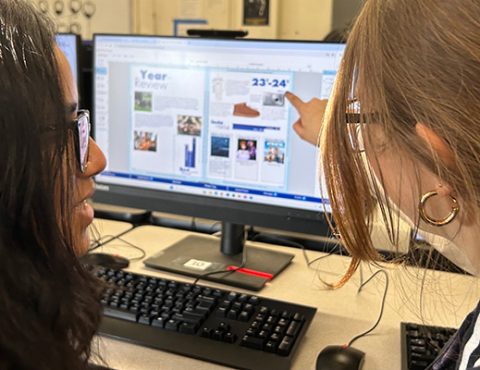Create a classroom routine for a class that isn’t a normal class. It sounds simple enough, but it can be overwhelming trying to get everyone on the same page, doing ice breakers to build up the team, jumping into yearbook ideas and settling students into a routine so class is fun and productive.
A few simple strategies can help jumpstart a routine, like having something to start the class, keeping them focused through daily work and settling students into feeling comfortable being creative.
Starting Class
If your class resembles mine, the start of the class can be the most chaotic. Students come in, ask what we are going to do today and talk to each other. So many things happen at the same time. Take a deep breath – it will help!
Sometimes it requires a little more than just a welcome or good morning to capture students’ attention and buckle down for work time. A normal class may have some bell work to get students started – that could be an option, but keep in mind this is not a normal class. One thing that worked for me in the past is playing a game. Yes, some students find it corny, but it captures their attention and helps you learn something about them.
I find having a visual agenda of some kind for students encourages them to get to work. Visual agendas can be as simple as having daily Google or PowerPoint slides or having a calendar off to the side of your board. However you set up your class, if you leave space for a daily agenda, it shows students this class is still a class and they are expected to do something during the allotted time.
With visual agendas, it helps students come in and work on an assignment or prep work to guide them into the lesson. Sometimes I have them write down a caption for a photo posted on the board while others take notes at their desk.
Daily Work
Keeping students engaged and busy during the class period can become tedious at times. If there isn’t work to complete on spreads in the yearbook or it’s the break period in between sports season, it can become a time where students struggle staying focused and being productive. This is when it’s important to create and keep daily activities to help grow the students’ skillset.
Daily work does not have to be extensive or even time consuming. A few simple options include practicing:
- Caption writing
- Interview questions
- Critiques
Caption Writing
Caption practice can be a good activity to look at the photos students captured while attending sports games or activity events. This daily work could take care of two birds with one stone.
First, think about how this picture can enhance the yearbook page and brainstorm fun, creative ways you can describe what is happening. If you don’t have new pictures, use photos from the previous year to help students learn this skill and understand what makes a picture yearbook worthy.
Interview Questions
Practicing interview questions should be continued throughout the school year for all the different spreads and activities that happen for maximum effectiveness. Some students find it difficult to talk to others, so pushing them out of their shells might help them feel more confident in those uncomfortable situations.
Besides pushing students to embrace the inevitable situation of conducting interviews, this practice encourages them to be ready to ask follow-up questions. We can always prepare and have our questions ready ahead of time, but sometimes that great quote that draws out the story happens when we least expect it. When that happens, students need to be ready to focus on that quote and encourage their interviewee to expand and provide more information.
Critiques
Critique practice has been one of the biggest challenges faced in my classroom. Some students fear if they provide a harsh critique on someone else’s work, then they might receive the same thing.
Starting critiques early not only encourages students to speak up about what they want to create in their yearbooks, but it also encourages them to feel more confident in their work. Typically, I start by pulling out previous yearbooks or even putting up sample spreads of my own for the students to critique. This provides a few steppingstones for them as they build their strengths as a team.
- First, it allows me to be vulnerable, which makes them more confident to work with me instead of feeling intimidated by me.
- Second, this allows them to see what has worked in the past and maybe what could have been improved.
- Third, it opens them to possible theme options to focus on for their yearbook.
Using Time
The start of class activity probably only takes about five to 10 minutes, leaving plenty of time to delve into the nitty gritty of the yearbook. Following that with a daily activity shows the students that while we are here to have fun and be creative, there is still work involved in this class. Once they finish that though, it’s time to really buckle down and get to the heart of the class. Creating a yearbook.
Following the classwork and diving into the creation includes anything from students separating in their assigned tasks and using their class time to work to coming together and making decisions on the spreads. It will take some time to decide who will be in what roles but once those are settled then the creation flows.
Having that end of the class time for photography uploads and design creation allows students to ask for help from each other and you. Even if it’s only 10 minutes, sometimes that is when the strongest work is completed. The daily work can also be an extension of their creation process if it’s a caption someone is currently working on or a spread design that is ready to be critiqued by editors.
Settling In
This class has many unique qualities. The first being that it’s a team effort to create a product that everyone in the school sees. The second is that it allows for fun times and memories to be shared by students who may not always hang out with each other. My favorite part is that by the end of the year after all the stress is done students celebrate with each other and how well they put together a product that they are proud of.
All of this starts by creating a routine. Creating that routine isn’t just about making sure you don’t stress as much. It does that also, but that is not the main focus. It’s about helping students settle in and be excited for the whole process of putting together a yearbook.
Having a routine can be simple as walking through lesson plans on the Walsworth training website or having a game or activity that starts each class. It shows the students that this class is unique and built on the personality of those that are in the room at that time. It also tells them they have the support they need in creating the best yearbook they can.





